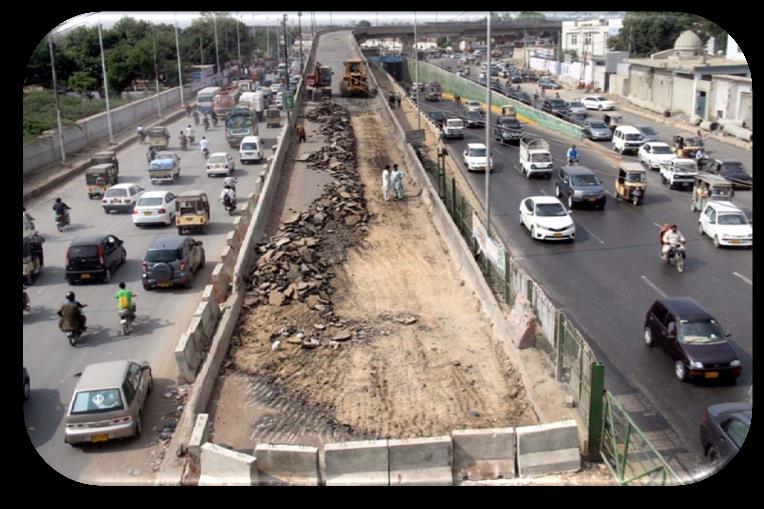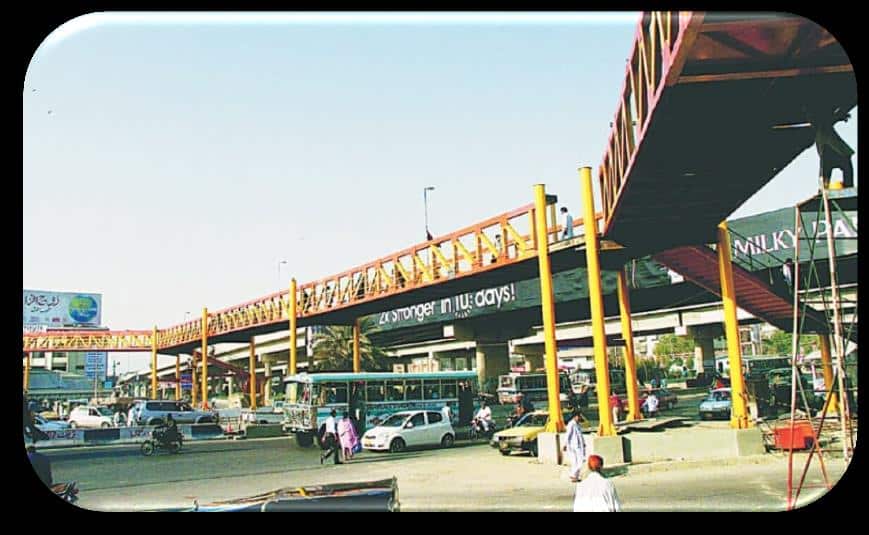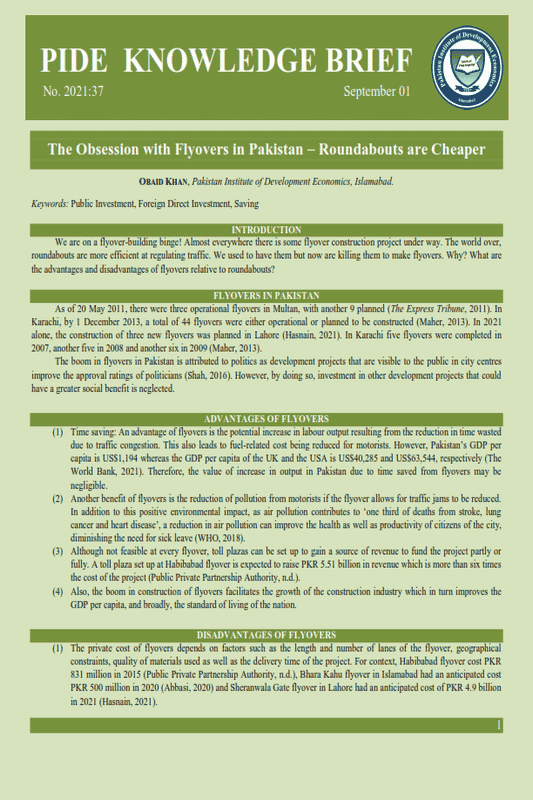The Obsession with Flyovers in Pakistan – Roundabouts are Cheaper
The Obsession with Flyovers in Pakistan – Roundabouts are Cheaper
INTRODUCTION
We are on a flyover-building binge! Almost everywhere there is some flyover construction project under way. The world over, roundabouts are more efficient at regulating traffic. We used to have them but now are killing them to make flyovers. Why? What are the advantages and disadvantages of flyovers relative to roundabouts?
FLYOVERS IN PAKISTAN
As of 20 May 2011, there were three operational flyovers in Multan, with another 9 planned (The Express Tribune, 2011). In Karachi, by 1 December 2013, a total of 44 flyovers were either operational or planned to be constructed (Maher, 2013). In 2021 alone, the construction of three new flyovers was planned in Lahore (Hasnain, 2021). In Karachi five flyovers were completed in 2007, another five in 2008 and another six in 2009 (Maher, 2013).
The boom in flyovers in Pakistan is attributed to politics as development projects that are visible to the public in city centres improve the approval ratings of politicians (Shah, 2016). However, by doing so, investment in other development projects that could have a greater social benefit is neglected.
ADVANTAGES OF FLYOVERS
- (1) Time saving: An advantage of flyovers is the potential increase in labour output resulting from the reduction in time wasted due to traffic congestion. This also leads to fuel-related cost being reduced for motorists. However, Pakistan’s GDP per capita is US$1,194 whereas the GDP per capita of the UK and the USA is US$40,285 and US$63,544, respectively (The World Bank, 2021). Therefore, the value of increase in output in Pakistan due to time saved from flyovers may be negligible.
- (2) Another benefit of flyovers is the reduction of pollution from motorists if the flyover allows for traffic jams to be reduced. In addition to this positive environmental impact, as air pollution contributes to ‘one third of deaths from stroke, lung cancer and heart disease’, a reduction in air pollution can improve the health as well as productivity of citizens of the city, diminishing the need for sick leave (WHO, 2018).
- (3) Although not feasible at every flyover, toll plazas can be set up to gain a source of revenue to fund the project partly or fully. A toll plaza set up at Habibabad flyover is expected to raise PKR 5.51 billion in revenue which is more than six times the cost of the project (Public Private Partnership Authority, n.d.).
- (4) Also, the boom in construction of flyovers facilitates the growth of the construction industry which in turn improves the GDP per capita, and broadly, the standard of living of the nation.
DISADVANTAGES OF FLYOVERS
- (1) The private cost of flyovers depends on factors such as the length and number of lanes of the flyover, geographical constraints, quality of materials used as well as the delivery time of the project. For context, Habibabad flyover cost PKR 831 million in 2015 (Public Private Partnership Authority, n.d.), Bhara Kahu flyover in Islamabad had an anticipated cost PKR 500 million in 2020 (Abbasi, 2020) and Sheranwala Gate flyover in Lahore had an anticipated cost of PKR 4.9 billion in 2021 (Hasnain, 2021).
- (2) On the other hand, the opportunity cost of constructing flyovers includes time wastage resulting from diversion of traffic to allow for the construction of the flyover. This also results in an increase in crime rates due to slow-moving traffic (World Road Association, 2019).
- (3) Furthermore, flyovers may not resolve traffic congestion once they become operational. An example would be higher-than-anticipated cars on the roads due to improper planning of the concerned development authority. Idling cars stuck in traffic would lead to greater air pollution and have a negative impact on the environment and on health of the residents of the city.
Fig. 1. Disruption Caused by the Construction of a Flyover in Peshawar

- (1) In the event of a collapse of a flyover either due to haste, use of substandard materials, heavy vehicles or not being adequately maintained, damage to private and public property as well as life could occur (Reuters, 2007). Examples of this include Habibabad Flyover collapsing seven months after its inauguration and Drigh Road Flyover being closed four times in six months for repairs (Ansari, 2016; The Express Tribune, 2017).
- (2) In addition to the financial cost of repairing these flyovers, time wastage occurs due to traffic being diverted to allow for these flyovers to be repaired.
Fig. 2. Drigh Road Flyover Being Repaired

- (1) Flyover construction is prone to time delays which in turn leads to cost overruns. An example of this was the cost increase of Sariab Phatak Flyover in Quetta in 2013 from PKR 1.3 billion to 1.6 billion due to delays in gaining site clearances (Business Recorder, 2013).
FLYOVERS VS ROUNDABOUTS—A COMPARISON
Like flyovers, roundabouts are efficient in terms of dealing with heavy traffic as they are signal-free. This improves traffic flow, saves time and fuel of motorists, and negates the adverse impact on the environment due to fewer emissions. Unlike flyovers, roundabouts promote a slow and consistent speed which helps reduce the incidence of fatal collisions (Washington State Department of Transportation, n.d.). They can also accommodate pedestrians and cyclists unlike most flyovers. Although overhead pedestrian bridges can be built over roads (and flyovers) to safely allow for pedestrians to cross the road, this would result in an additional cost being incurred, making flyovers even less feasible relative to roundabouts.
Fig. 3. Overhead Pedestrian Bridge in Karachi

Roundabouts are comparable in costs to traffic signals, not flyovers. However, unlike traffic signals, they do not incur any maintenance and electrical costs that range from US$5,000 – 10,000 annually for traffic signals (Washington State Department of Transportation, n.d.). Therefore, in the long-run, they prove to be cheaper than traffic signals, let alone flyovers. Although they require more space than a traffic signal to construct, roundabouts require less space than flyovers and are quicker to construct (Insurance Institute for Highway Safety, 2021).
Due to these benefits of roundabouts, other cities in the world have steered away from flyovers; Paris has no flyovers and Seoul has replaced a flyover at Cheonggyecheon with a river (Maher, 2013).
A reason behind Pakistan’s, and in particular, Karachi’s obsession with flyovers is the success of the first flyover constructed in the city at Nazimabad which helped deal with traffic congestion efficiently. Over the years however, flyovers in Karachi have been constructed primarily for the purpose of creating a ‘signal-free corridor’ (Maher, 2013). Had Karachi relied on roundabouts instead of flyovers, not only would it have been able to free-up resources for other projects, it would have also had a more efficient, environment-friendly, cheaper and safer method of dealing with traffic congestion. A study conducted five months after the first signal-free corridor was inaugurated in Karachi in 2007 established that vehicle-related accidents more than doubled from 206 to 438 and traffic congestion remain unchanged (Maher, 2013). Despite Karachi’s apparent obsession with speed and flyovers, the average speed in the city is 11.2 miles per hour, the second worst in the world (Gorzelany, 2017).
Pakistan’s latest Automobile Development Policy has subsidised cars to boost their ownership levels by making entry level cars more affordable. In 2018, there were 23.6 million registered cars in the country (APP, 2019). Given Pakistan’s population in 2018 (212 million), this subsidy would benefit only 11 percent of the total population, assuming every car owner did not own multiple cars. Moreover, to accommodate this subsidy-resultant increase in cars, Pakistani cities will become more car-dependent given Pakistan’s preference for flyovers over roundabouts.
CONCLUSION
Pakistan has experienced a boom in flyovers in recent years. This can be partly attributed to a political ploy which diverts investment away from development-related projects to tangible infrastructure-related projects such as flyovers which often experience delays and cost overruns. Constructing these flyovers also results in temporary traffic congestion and upon completion, some flyovers do not alleviate the issue of traffic congestion due to poor planning on behalf of development authorities. Although flyovers have their benefits, their private and social cost deems them unfeasible for Pakistan, a country with strained financial resources. It would be more advisable to build cheaper roundabouts instead of flyovers. They are cheaper and faster to construct, safer and just as efficient as flyovers, if not more.
REFERENCES
Abbasi, K. (2020). Design for Bhara Kahu, Tarnol flyovers to be completed within five months, Dawn, viewed 7 July 2021, https://www.dawn.com/news/1527111.
Ansari, A. (2016). Habibabad flyover – a story of undue haste, Dawn, viewed 6 July 2021, https://www.dawn.com/news/1237273.
APP, Registered vehicles in Pakistan increased by 9.6% in 2018, Pakistan Today, viewed 14 July 2021, https://profit.pakistantoday.com.pk/2019/06/16/registered-vehicles-in-pakistan-increased-by-9-6-in-2018/.
Business Recorder (2013). Quetta flyover cost overruns, Business Recorder, viewed 12 July 2021, https://fp.brecorder.com/2013/10/201310131241087/.
Gorzelany, J. (2021). The World’s best and worst cities for drivers, Forbes, viewed 14 July 2021, https://www.forbes.com/sites/jimgorzelany/2017/09/27/the-worlds-best-and-worst-cities-for-drivers/?sh=34a67b4042e9.
Hasnain, K. (2021). Construction work on five mega projects in Lahore likely to begin next month, Dawn, viewed 7 July 2021, https://www.dawn.com/news/1611068/construction-work-on-five-mega-projects-in-lahore-likely-to-begin-next-month.
Insurance Institute for Highway Safety (2021). Roundabouts, viewed 9 July 2021, https://www.iihs.org/topics/roundabouts.
Maher, M 2013, Fall sick with the healing: The ‘killer’ history of Karachi’s first flyover, The Express Tribune, viewed 6 July 2021, https://tribune.com.pk/story/639770/fall-sick-with-the-healing-the-killer-history-of-karachis-first-flyover.
Public Private Partnership Authority (n.d.). Construction of Habibabad flyover on BOT basis, viewed 6 July, https://www.pppa.gov.pk/c_habibabad.php.
Reuters (2007). Overpass collapses in Pakistan, 2 dead, Reuters, viewed 6 July 2021, https://www.reuters.com/article/idUSSP175921.
Shah, S. (2016). Flyovers in Peshawar used by all parties as a political strategy, Dawn, viewed 9 July 2021, https://www.dawn.com/news/1231582.
The Express Tribune (2011). Two bridges, eight flyovers in Multan ‘almost complete’, viewed 12 July 2021, https://tribune.com.pk/story/172163/highway-infrastructure-two-bridges-eight-flyovers-in-multan-‘almost-complete’.
The Express Tribune (2017). Drigh Road Flyover closed for the umpteenth time, viewed 9 July 2021, https://tribune.com.pk/story/1557404/drigh-road-flyover-closed-umpteenth-time.
The World Bank (2021). GDP per capita (current US$) – United Kingdom, United States, Pakistan, The World Bank, viewed 12 July 2021, https://data.worldbank.org/indicator/NY.GDP.PCAP.CD?locations=GB-US-PK.
Washington State Department of Transportation (n.d.). Roundabout benefits, viewed 9 July 2021, https://wsdot.wa.gov/Safety/roundabouts/benefits.htm.
World Health Organisation (2018). How air pollution is destroying our health, World Health Organisation, viewed 12 July 2021, https://www.who.int/news-room/spotlight/how-air-pollution-is-destroying-our-health.
World Road Association (2019). Impact of flyovers on traffic situation of a metropolitan city: A case study of Karachi-Pakistan. The National Institute of Science, Engineering and Medicine, viewed 7 July 2021, https://trid.trb.org/view/1737449.




